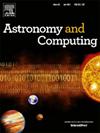射电天文台的先进数据产品
IF 1.8
4区 物理与天体物理
Q2 ASTRONOMY & ASTROPHYSICS
引用次数: 0
摘要
先进数据产品(adp)对于提高射电天文台的效率和科学产出越来越重要。adp旨在弥合原始观测数据和科学就绪结果之间的差距,减少处理开销,提高可重复性,并使更广泛的研究人员能够参与复杂的数据集。它们的好处包括加速研究、跨档案的互操作性、减少重复的计算工作,以及对可持续性的直接影响。本文总结了ADP2024研讨会的成果,该研讨会回顾了包括ALMA、SKAO、LOFAR、VLA和ESO在内的主要设施的当前实践。我们强调从正在进行的倡议中吸取的经验教训。确定的关键问题包括标准化、来源跟踪、质量保证和长期维护。我们认为,adp是射电天文学迈向可持续、可获取和科学优化数据生态系统的关键一步。本文章由计算机程序翻译,如有差异,请以英文原文为准。
Advanced Data Products for radio observatories
Advanced Data Products (ADPs) are increasingly central to enhancing the efficiency and scientific output of radio observatories. Designed to bridge the gap between raw observational data and science-ready results, ADPs reduce processing overhead, improve reproducibility, and enable a wider range of researchers to engage with complex datasets. Their benefits include accelerated research, interoperability across archives, and reduced duplication of computational effort, with direct implications for sustainability. This paper summarizes the outcomes of the ADP2024 workshop, which reviewed current practices at major facilities including ALMA, SKAO, LOFAR, VLA, and ESO. We highlight lessons learned from ongoing initiatives. Critical issues identified include standardization, provenance tracking, quality assurance, and long-term maintenance. We conclude that ADPs represent a key step toward sustainable, accessible, and scientifically optimized data ecosystems in radio astronomy.
求助全文
通过发布文献求助,成功后即可免费获取论文全文。
去求助
来源期刊

Astronomy and Computing
ASTRONOMY & ASTROPHYSICSCOMPUTER SCIENCE,-COMPUTER SCIENCE, INTERDISCIPLINARY APPLICATIONS
CiteScore
4.10
自引率
8.00%
发文量
67
期刊介绍:
Astronomy and Computing is a peer-reviewed journal that focuses on the broad area between astronomy, computer science and information technology. The journal aims to publish the work of scientists and (software) engineers in all aspects of astronomical computing, including the collection, analysis, reduction, visualisation, preservation and dissemination of data, and the development of astronomical software and simulations. The journal covers applications for academic computer science techniques to astronomy, as well as novel applications of information technologies within astronomy.
 求助内容:
求助内容: 应助结果提醒方式:
应助结果提醒方式:


